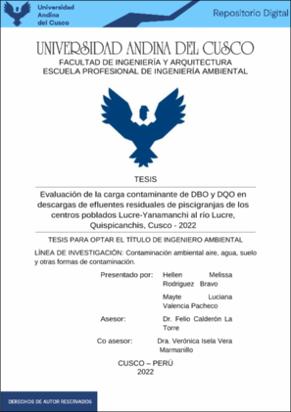Evaluación de la carga contaminante de DBO y DQO en descargas de efluentes residuales de piscigranjas de los centros poblados Lucre-Yanamanchi al río Lucre, Quispicanchis, Cusco - 2022

Date
2023-03-03Author
Rodríguez Bravo, Hellen Melissa
Valencia Pacheco, Mayte Luciana
Advisor
Vera Marmanillo, Verónika Isela
Calderón La Torre, Felio
Metadata
Show full item recordAbstract
El objetivo fue evaluar la carga contaminante de DBO y DQO de las descargas de
efluentes residuales de las piscigranjas de los centros poblados Lucre-Yanamanchi al río Lucre.
Se tomaron 16 muestras de 8 descargas, considerando la estacionalidad. Se determinaron
parámetros de campo físico-químicos con un equipo multiparamétrico de agua (M&A
instruments AZ86031): pH, conductividad y temperatura. Se utilizó un medidor de corriente
portátil LG-4 (caudalímetro) para determinar el caudal (m3/h). Se tomaron muestras de DBO y
DQO en frascos de boca ancha y angosta correspondientemente, se conservaron y llevaron a
laboratorio para su análisis usando métodos estandarizados. Los resultados de laboratorio
permitieron calcular la carga contaminante correspondiente a la cantidad de contaminante que
se descarga por unidad de tiempo, expresado en kg/día.
Las características físico-químicas de las descargas resultaron ser ligeramente ácidas,
sin presencia de sales. El mayor valor de DQO es el Punto de Monitoreo (PM) 006 con una
concentración de 537.3 mg/L; el menor, es el PM-004 con 200mg/L. Mientras para la DBO el
mayor valor lo tiene el PM-008 con 230mg/L y el menor, el PM-008 con 42mg/L.
Los resultados de carga contaminante de DBO y DQO son altos. Para DBO5, de acuerdo
a las metas del Quinquenio de 2016 – 2021 para actividades acuícolas; todos los puntos de
monitoreo, con excepción del PM-001 y PM-002 en época de lluvias, exceden el límite
establecido (50kg/día); llegando a su mayor valor en el PM-004 con 731.71 kg/día. The objective was to evaluate the pollutant load of BOD and COD of residual effluent
discharges from the Lucre-Yanamanchi small population fish-farms to the Lucre river. 16
samples of 8 discharges were taken, considering the season. Physicochemical field parameters
were determined with multiparameter water (M&A instruments AZ86031): pH, conductivity
and temperature. An LG-4 portable current meter (flowmeter) was used to determine the flow
(m3/h). BOD and COD samples were taken with a wide mouth jar and a narrow mouth jar
correspondingly; they were preserved and taken to laboratory for analysis using standardized
methods. The laboratory results made it possible to calculate the pollutant load corresponding
to the amount of pollutant that is discharged per unit of time, expressed in kg/day.
The physicochemical characteristics of the discharges turned out to be slightly acid,
without the presence of salts. The highest value of COD is the Monitoring Point (PM) 006 with
a concentration of 537.3 mg/L; the lowest is PM-004 with 200mg/L. While for the BOD the
highest value is in PM-008 with 230mg/L and the lowest, PM-008 with 42mg/L.
The pollutant load results for BOD and COD are high. For BOD5, according to the goals
of the 2016 - 2021 Five-Year Period for aquaculture activities; all monitoring points, exception
of PM-001 and PM-002 in the rainy season, exceed the established limit (50kg/day); reaching
its highest value in PM-004 with 731.71 kg/day.

